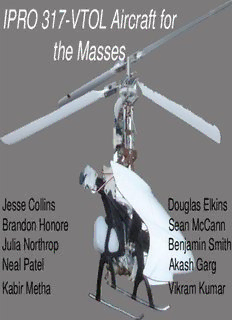
IPRO 317-VTOL Aircraft for the Masses - repository.iit Home PDF
Preview IPRO 317-VTOL Aircraft for the Masses - repository.iit Home
IPRO 317-VTOL Aircraft for the Masses Jesse Collins Douglas Elkins Brandon Honore Sean McCann Julia Northrop Benjamin Smith Neal Patel Akash Garg Kabir Metha Vikram Kumar Allow Us To Introduce… • VTOL – Vertical Take off and Landing • The Volar consists of a twin-rotor configuration • VTOL aircraft does not need a tail rotor • Full control over the movement of the VTOL aircraft and a limited take-off sequence has been conducted. • In X-Plane Version 8.0, both a small-scale and full-scale prototype simulation have been successfully executed. Construction and Testing Objectives • Complete airframe, gimbal control, engine test of aircraft, and test with rotors attached • Design, determine placement, and install wing and tail structures. • Achieve operational flight status; begin tests outdoors • Improve design of components throughout the testing process. Progress • Completed construction of all servo motors and control arms for the gimbal mechanism • Balanced and attached rotors and achieved engine startup • Reinforced gimbal structure • Diagnosed problems • Limiting blocks for gimbal motion • Constructed tail control surface and servo and cleaned up wiring and controls • Achieved lift and directional thrust during tests with rotors Obstacles and Setbacks • Loss of engine control during tests • Replacement of main gear • Difficulty of obtaining parts X-Plane What is it? • Flight simulation, Plane design How does it work? • Blade element theory- user specifies geometry, program numerically integrates over defined surfaces and sums to get net forces Objectives Full Scale model • Wingspan: 22ft • Fuselage length:15ft • 140hp reciprocating engine • Propeller radius: 10.6ft • Empty weight: 8,500lb Full Scale Model Progression of Assignments • Updated older volar file from an obsolete version of X-Plane • Added rudder for increased stability and yaw control • Optimization
Description: